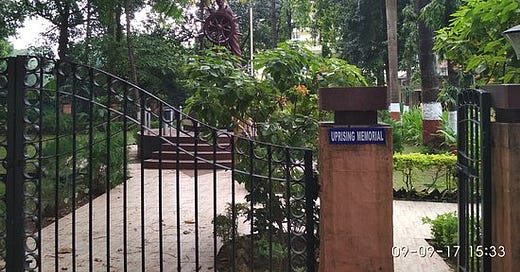Five days of February that led India to Freedom
The Naval, Airforce, and Army Rebellion of February 1946.
The British Rule in India was won by the sword and imposed by Civil service using the Army and Police as its arms. The Army’s primary purpose was not defending against foreign armies but imposing rule, and hence, there were cantonments in the Major cities so that the army could reach where required quickly.
The British Indian Army, which expanded from 300,000 at the start of the war to 2.5 million by the end, never wavered in its loyalty to the British Raj, except for the POWs taken by Japan, who joined the Indian National Army. Under Commander-in-Chief Subhas Chandra Bose, they fought alongside Japan to liberate India from its eastern borders. They began liberating Indian territory, which was placed under the Provisional Government of Free India. This government received international recognition from nine countries and was based in Singapore. Over 330,000 Indians living in Southeast Asia took an oath of allegiance to this government, which established a bank, a postal service, and various ministries.
When the Japanese surrendered, INA soldiers who were formerly in the British Indian Army were brought to India as prisoners- some via Land routes, but most of them by ships from Singapore and Rangoon.
The British categorized most of these INA soldiers inspired by Bose as having’ their heads turned’.
On the way back to India, interactions with various ratings on the ships also turned nationalist. After the first three INA officers were prosecuted, feelings had been building up. On February 1st, a rating named R.K. Singh resigned, and when Navy Day was celebrated, banners reading “QUIT INDIA” and “REVOLT NOW” were part of the decorations, causing significant embarrassment to the British. Dissatisfaction continued to grow amid various incidents.
In 1946, on February 18th, in sympathy for B.C. Dutt, who had been caught and imprisoned for exceeding the ratings on Signal Ship HMIS Talwar, decided to go on a hunger strike.
Within hours, the protests spread to nearly all Naval Stations, and at its peak, 70 ships in Bombay, Karachi, and other locations were involved, engaging 20,000 ratings.
The Air Force followed next, and the Indian battalions that were ordered to fire on the ratings refused to do so.
The ships opened fire on British lines in Bombay and Karachi, and the rebellion was suppressed by the involvement of 100% British Army units, along with the participation of the Congress and the Muslim League to quell it.
However, the Indian Army, Navy, and Air Force no longer supported the British. Meanwhile, the country erupted with agitations, strikes, and protests, including against the police and post offices.
Without the ability to impose rule, on March 15th, the British announced their decision to leave India and started working towards handing over power to an all-party, all-Indian cabinet, but still meet the Imperial goals as best as possible.
Jawahar Lal Nehru took the oath as Prime Minister of India on September 2, 1946, under the British Viceroy. India became a dominion on August 15, 1947, and an independent republic on January 26, 1950.
British records show clearly that the reason was the collapse of the control system starting with Naval rebellion.
The five-day naval rebellion, which lasted from February 18th to 23rd, was the final act that led to the release of almost one-sixth of humanity from slavery.



